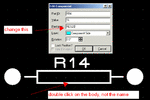epilot
Member level 2
Hello guys,
I have several 0.4in resistors in Proteus software which want to movie them to PCB section. I just want to use the said resistors in Standup state so that reduce the size of my PCB layout. a size between 0.2 inch and 0.15 inch would be ok. Can you guys tell me please how to change the size of a resistor or how to do what I need? I made a search but I was not able to find any suitable resistor with the sizes Which I need.
Thanks for any help
I have several 0.4in resistors in Proteus software which want to movie them to PCB section. I just want to use the said resistors in Standup state so that reduce the size of my PCB layout. a size between 0.2 inch and 0.15 inch would be ok. Can you guys tell me please how to change the size of a resistor or how to do what I need? I made a search but I was not able to find any suitable resistor with the sizes Which I need.
Thanks for any help
